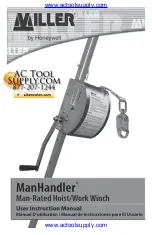
InstructIons for:
enclosed
GeARed WIncH 1200lb
MoDEL no:
GWe1200.v2
thank you for purchasing a sealey product. Manufactured to a high standard this product will, if used according to these instructions
and properly maintained, give you years of trouble free performance.
1. sAFeTY InsTRUcTIons
IMPORTANT:
PleAse ReAd THese InsTRUcTIons cAReFUllY. noTe THe sAFe oPeRATIonAl ReQUIReMenTs, WARnInGs & cAUTIons.
Use THe PRodUcT coRRecTlY And WITH cARe FoR THe PURPose FoR WHIcH IT Is InTended. FAIlURe To do so MAY cAUse
dAMAGe And/oR PeRsonAl InJURY And WIll InvAlIdATe THe WARRAnTY. PleAse KeeP InsTRUcTIons sAFe FoR FUTURe Use.
WARnInG! Winch is not designed for lifting or slinging loads. It is intended only for pulling a load and must be used with care.
fit only appropriately rated cable and hook suitable for the task for which the winch is to be used.
Ensure the winch is maintained in a safe working condition. Inspect the cable regularly checking for fraying, kinks, broken strands or
distortion. If such is present, replace the cable. check all component parts, do not use if damaged, contact authorised service agent.
Most truck beds are not designed to support the pulling capacity of a winch. choose an appropriately strong winching point, which we
recommend is reinforced with steel plates and appropriate securing bolts. the winch mounting point must be capable of withstanding
4 x the maximum rated capacity of the winch.
WARnInG! Keep hands, your body and clothing away from the winch components and the cable. Use a rag or protective gloves
when handling cable.
Take any necessary precautions to protect your personal safety whilst using the winch.
for a heavy load place a blanket (or jacket) over extended cable about 2 feet away from the hook in order to lessen the severity of a
cable break.
WARnInG! ensure you know how much load you are winching. never exceed the maximum pulling capacity. Take into account
any angle of incline over which the load must be pulled. Also account for winching loads from thick mud, or through snow or
water. chock the wheels of vehicles to be winched then release any brakes and place gears in neutral, ensure the load is capable
of free movement before winching. Take up the strain on the cable and remove the wheel chocks to move the load.
Ensure the load to be pulled has an appropriate fixing point. If not, fit an adequate sling, eyebolt or other accessory to the load. Ensure
accessories are equal to, or exceed, the maximum pulling capacity of the winch.
Ensure cable is securely attached to the load before winching.
Maintain correct balance and footing whilst using the winch.
remove ill fitting clothing. remove ties, watches, rings and other loose jewellery, and contain and/or tie back long hair.
Keep children and non essential persons away from the operating area. Be aware of the location of other persons assisting you.
Apply even and steady pressure to the handle when releasing the tension from the load.
Do not operate the winch if any parts are damaged or missing as this may cause failure and/or personal injury.
WARnInG! do noT use winch as a lifting device of any type.
do noT use the winch for any purpose other than for which it is
designed.
WARnInG! do noT exceed the rated pulling capacity of the winch.
Do not pull the cable over or around a corner and Do not take the hook around the load and hook back onto the cable. use
appropriate sling if necessary.
Do not operate the winch with less than tHrEE wraps of cable on the drum.
DANGER! DO NOT use any “cheater” pipe, lever, or other device to lengthen the handle for additional leverage, as the pulley may
fail causing damage and possible personal injury. If the winch can not be operated by hand, it may be overloaded.
Do not operate the winch if you are tired or under the influence of alcohol, drugs or intoxicating medication.
WARnInG! The warnings, cautions and instructions discussed in this manual cannot cover all possible conditions and situations
that may occur. It must be understood that common sense and caution are factors which cannot be built into this product, but
must be applied by the operator.
sPecIFIcATIon
Pulling capacity (first layer of cable on drum). . . . . . . . . 544kg
(Last layer of cable on drum). . . . . . . . . 172kg
Drum capacity (cable dia. x length). . . . . . . . . Ø4.76mm x 16m
Hand force required . . . . . . . . . . . . . . . . . . . . . . . . . . . . . 13.5kg
ratio . . . . . . . . . . . . . . . . . . . . . . . 4.1:1
Hub diameter . . . . . . . . . . . . . . Ø33mm
unit weight . . . . . . . . . . . . . . . . . . 3.5kg
2. InTRodUcTIon & sPecIFIcATIon
3.1.
InsTAllInG WIncH.
Most truck beds are not designed to support the pulling capacity of a winch.
choose an appropriately strong winching point, which when fitted will give
the winch handle enough clearance to turn.
We recommend that the fixing point is reinforced with steel plate.
Ensure the fixing bolts are adequate for securing the winch with a full load.
the winch mounting point must be capable of withstanding 4 x the
maximum rated capacity of the winch.
for fixing dimensions see fig 1.
3. InsTAllATIon
Fig 1
Original Language Version
GWE1200.V2 Issue: 2 - 28/01/10














